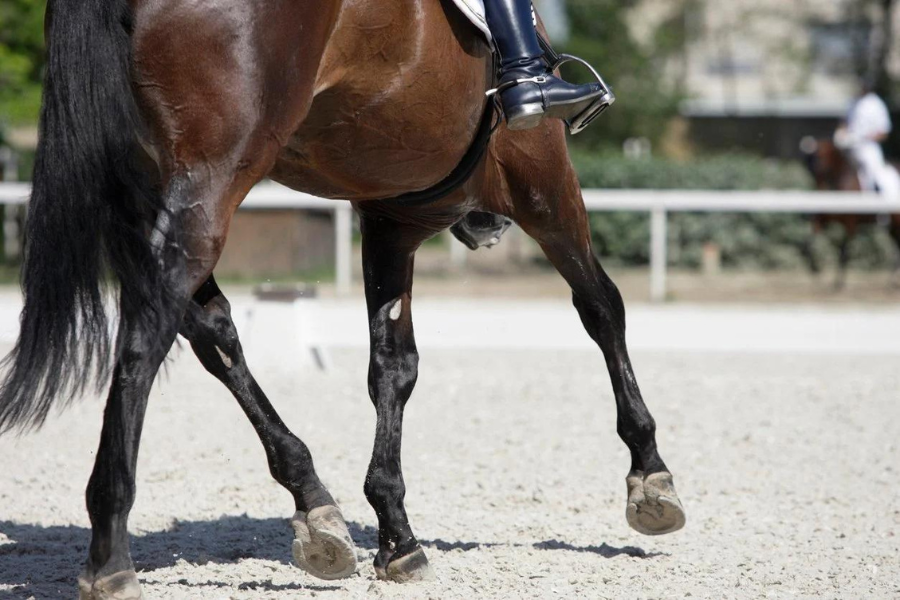Locking stifle, also known as upward fixation of the patella, is a common issue that can affect horses, causing discomfort and mobility problems. As an equine osteopathy practice, we aim to provide comprehensive care and support for your horse’s musculoskeletal health. Here, we delve into what locking stifle is, its treatments, ways to strengthen your horse’s stifle, and which horses are predisposed to this condition.
What is Locking Stifle?
Locking stifle occurs when the patella (kneecap) becomes temporarily fixed in place over the femur’s medial trochlear ridge. This prevents the stifle joint from bending and can cause the horse to drag its hind leg. The condition can be intermittent or constant and is often noticed when the horse starts moving after rest.
Symptoms of Locking Stifle:
- Intermittent catching or locking of the stifle joint
- Dragging of the hind leg
- Difficulty in moving or getting up
- Visible discomfort or lameness
Causes and Predispositions
Several factors can predispose a horse to locking stifle, including:
- Conformation: Horses with straight hind leg conformation or poor musculoskeletal alignment are more susceptible.
- Age and Development: Young horses whose muscles and ligaments are still developing can experience this condition.
- Fitness Level: Horses with weak or underdeveloped muscles around the stifle are at higher risk.
- Breed: Certain breeds, particularly those with straight hind leg conformation like the Quarter Horse and some Warmbloods, are more prone to locking stifle.
Treatment Options
Addressing locking stifle often requires a combination of veterinary intervention and supportive therapies. Here are common treatments:
- Exercise and Physical Therapy: Strengthening exercises to build the muscles around the stifle joint can help alleviate the condition.
- Medications: Anti-inflammatory medications or muscle relaxants may be prescribed by a veterinarian.
- Surgical Intervention: In severe cases, surgical options such as medial patellar ligament splitting or medial patellar desmotomy may be considered.
- Equine Osteopathy: Osteopathic treatments can help realign the musculoskeletal system, improving overall function and reducing the likelihood of locking stifle.
Strengthening Your Horse’s Stifle
Building strength in the stifle area is crucial for preventing and managing locking stifle. Here are exercises and tips to help strengthen your horse’s stifle:
- Hill Work: Walking and trotting up and down gentle slopes can build muscle strength and improve joint stability.
- Cavaletti Training: Incorporating cavaletti poles into your training can enhance hind leg coordination and muscle tone.
- Lunging: Regular lunging, especially with emphasis on transitions, helps improve muscle condition without the weight of a rider.
- Backing Up: Asking your horse to back up in hand can engage the muscles around the stifle and promote better control.
- Targeted Stretching: Incorporate specific stretches that target the stifle area to improve flexibility and range of motion.
Preventative Measures
To minimize the risk of locking stifle, consider these preventative measures:
- Maintain Regular Exercise: Consistent, balanced exercise routines help keep the muscles around the stifle strong and flexible.
- Proper Nutrition: Ensure your horse’s diet supports muscle health and joint function, with adequate levels of essential nutrients.
- Regular Check-ups: Regular veterinary and osteopathic check-ups can catch early signs of locking stifle and other musculoskeletal issues.
Locking stifle can be a challenging condition for horses, but with proper management and care, your horse can lead a comfortable and active life. Osteopaths specialize in diagnosing and treating musculoskeletal issues, including locking stifle. By combining osteopathic treatments with targeted exercise programs, we aim to enhance your horse’s health and performance. If you suspect your horse has locking stifle or if you need guidance on strengthening exercises, don’t hesitate to contact us for professional support.
